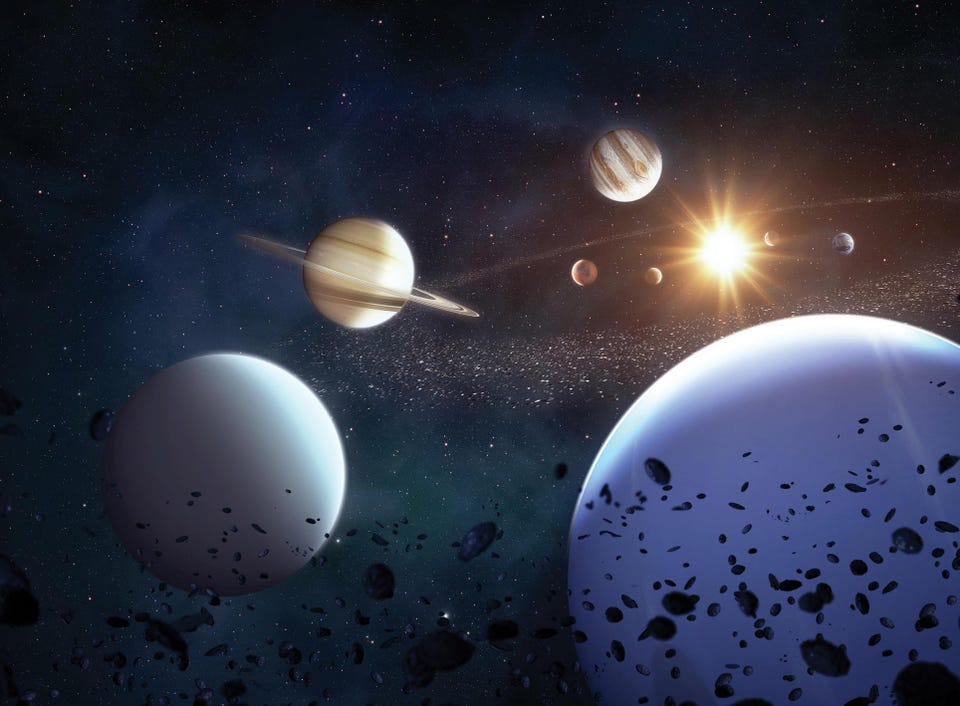Science The Planet-Fest Is Almost Over. This Weekend Is Your Last Chance To See Six Planets In One Sky Jamie Carter Senior Contributor Opinions expressed by Forbes Contributors are their own. I inspire people to go stargazing, watch the Moon, enjoy the night sky New! Follow this author to stay notified about their latest stories.
Got it! Aug 19, 2022, 04:20am EDT | New! Click on the conversation bubble to join the conversation Got it! Share to Facebook Share to Twitter Share to Linkedin Illustration of the Solar System viewed from beyond Neptune, with all eight planets visible around . . .
[+] the Sun, created on April 14, 2016. (Illustration by Tobias Roetsch/Future Publishing via Getty Images) Future Publishing via Getty Images Early-risers will have become familiar with 2022’s pre-dawn parade of planets—but it’s about to end. This weekend is the last chance to glimpse the four bright planets—Venus, Mars, Jupiter and Saturn—together in the same night sky and arranged in their natural order from the Sun.
Those with telescope will also be able to spot Uranus and Neptune. You’re going to have to be up and outside about an hour before sunrise to see the four planets, which will span the ecliptic from east to west. Venus will be rising in the east and Saturn will be setting in the west.
The ecliptic is the path the Sun takes through the sky. It’s also the plane of the solar system that all the planets orbit on. Here’s where each planet will be and a few bonus sights to see around each one: The position of the four naked-eye planets this weekend from mid-northern latitudes.
Stellarium Venus: rising in the east an hour before sunrise Incredibly bright at magnitude -3. 9, the “Morning Star” is incredibly bright and perhaps the highlight of all the four naked-eye planets. Don’t confuse it with Sirius, the brightest star in the night sky, which will be shining just to the right of Venus low in the east.
Above Sirius is the constellation of Orion. MORE FOR YOU New Research Finds A Connection Between Domestic Violence And These Two Personality Disorders This Scientist Helps Andean Forests And Ecuador’s Women In STEM Exceptional Fossil Preservation Suggests That Discovering Dinosaur DNA May Not Be Impossible Mars: in the southeast The red planet is getting brighter at it gets closers to Earth—something that will peak in December when it reaches its brightest. Tonight it’s high in the sky right alongside a 37%-lit waning Moon and the closest open cluster of stars to us, the Pleiades.
It’s six or seven naked-eye blue stars will contrast beautifully with the redness of Mars. If you want to appreciate just how bright the Pleiades are then glance just t the side of it—your eyes will see more brightness that way. Mars passing below the blue Pleiades star cluster (aka M45 and the Seven Sisters) on the evening of .
. . [+] March 3, 2021.
(Photo by: Alan Dyer/VW Pics/Universal Images Group via Getty Images) VW Pics/Universal Images Group via Getty Images Jupiter: in the southwest The “king of planets” won’t reach its brightest of the year until next month, but its already putting on a show. Shining at a magnitude of -2. 8, its disk is now 99.
6% illuminated. It’s a great time to put it in binoculars or a small telescope to glimpse its pink bands and its four large moons Europa, Io, Callisto and Ganymede. You’ll see them as a line of white dots either side of Jupiter.
Uranus and Neptune: bonus planets If you have a large telescope then know that Uranus is between Mars and Jupiter while Neptune is between Jupiter and Saturn. Saturn: setting in the west Saturn reached its bright opposition last weekend , but the ringed planet will continue to shine relatively brightly for a few more weeks yet. It will be shining in the west as it sets.
Any small telescope will afford you a glimpse of the incredible ring pattern surrounding the sixth planet from the Sun. Planetary alignments like this aren’t common. However, the one to wait for comes on September 8, 2040 when Mars, Mercury, Venus, Saturn and Jupiter visible in the same tiny 10º patch of the night sky right after sunset in the west.
That’s one for your long-range diary! Wishing you clear skies and wide eyes. Follow me on Twitter or LinkedIn . Check out my website or some of my other work here .
Jamie Carter Editorial Standards Print Reprints & Permissions.
From: forbes
URL: https://www.forbes.com/sites/jamiecartereurope/2022/08/19/the-planet-fest-is-almost-over-this-weekend-is-your-last-chance-to-see-six-planets-in-one-sky/



